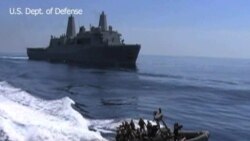PENTAGON —
As the United States and Russia engage in diplomatic efforts for the government of Syrian leader Bashar al Assad to hand over its chemical weapons, U.S. forces remain poised to strike and they're standing by with more than just military hardware.
Despite the intensifying diplomatic efforts on Syria, four U.S. destroyers are staying in their positions in the eastern Mediterranean, with scores of Tomahawk missiles ready to fire.
Speaking to an audience at the National Defense University, Navy Secretary Ray Mabus said there has been no change in plans for the vessels.
"I guarantee you that if we are called upon to strike, we will strike hard and we will strike fast," said Mabus.
Ships and cruise missiles are among a wide range of options the Pentagon has ready, if and when the order comes from the White House to strike.
Cyber defenses are also an important component of the strike plan.
Pro-Assad forces have been launching cyber attacks against U.S. targets and are blamed for the recent hacking of a U.S. Marines recruiting website.
Pentagon spokesman Lieutenant Colonel Damien Pickart says the United States has been training its cyber forces to be equipped and ready to deal with any threat.
“If any nation or group chooses to use cyberspace against the interests of the United States or against the United States, we will use our cyber forces to prepare to defend ourselves and provide appropriate responses," said Pickart.
Details of the plans for a cyber offensive are a closely guarded secret, says defense analyst Anthony Cordesman:
“To know how dependent the Syrian government really is on systems that can be affected by cyber warfare is one of the most sensitive areas of intelligence that we have. And the thing that you also have to remember is you do not want in a limited case to give away anything like the most sophisticated capabilities you have because you provide a detailed warning in terms of far more serious contingencies," said Cordesman.
For now, U.S. ships are standing by near Syria as a show of force. The carrier USS Nimitz is on an extended assignment in the Red Sea for at least a few more days.
Despite the intensifying diplomatic efforts on Syria, four U.S. destroyers are staying in their positions in the eastern Mediterranean, with scores of Tomahawk missiles ready to fire.
Speaking to an audience at the National Defense University, Navy Secretary Ray Mabus said there has been no change in plans for the vessels.
"I guarantee you that if we are called upon to strike, we will strike hard and we will strike fast," said Mabus.
Ships and cruise missiles are among a wide range of options the Pentagon has ready, if and when the order comes from the White House to strike.
Cyber defenses are also an important component of the strike plan.
Pro-Assad forces have been launching cyber attacks against U.S. targets and are blamed for the recent hacking of a U.S. Marines recruiting website.
Pentagon spokesman Lieutenant Colonel Damien Pickart says the United States has been training its cyber forces to be equipped and ready to deal with any threat.
“If any nation or group chooses to use cyberspace against the interests of the United States or against the United States, we will use our cyber forces to prepare to defend ourselves and provide appropriate responses," said Pickart.
Details of the plans for a cyber offensive are a closely guarded secret, says defense analyst Anthony Cordesman:
“To know how dependent the Syrian government really is on systems that can be affected by cyber warfare is one of the most sensitive areas of intelligence that we have. And the thing that you also have to remember is you do not want in a limited case to give away anything like the most sophisticated capabilities you have because you provide a detailed warning in terms of far more serious contingencies," said Cordesman.
For now, U.S. ships are standing by near Syria as a show of force. The carrier USS Nimitz is on an extended assignment in the Red Sea for at least a few more days.









